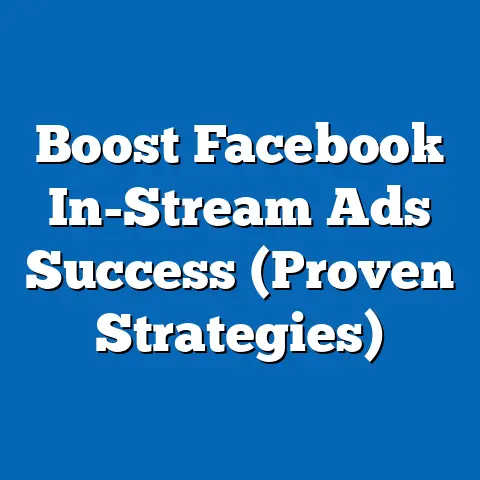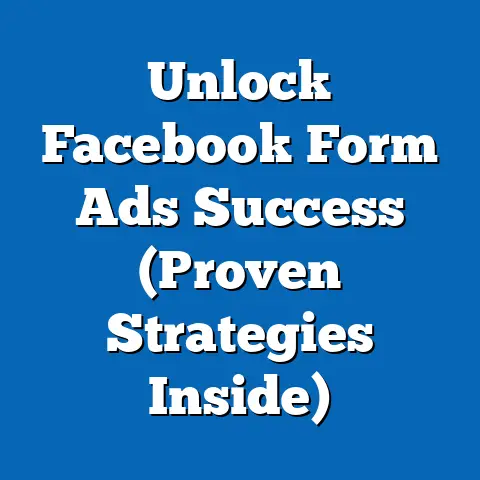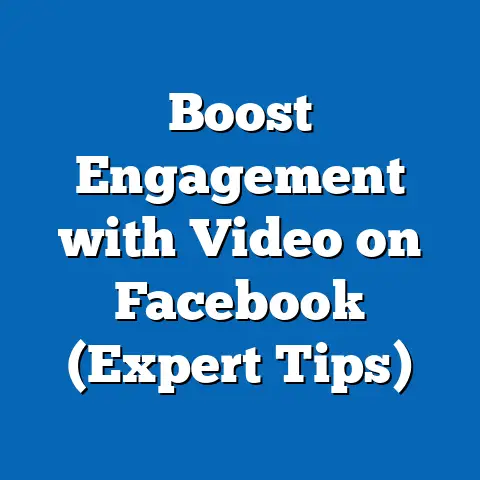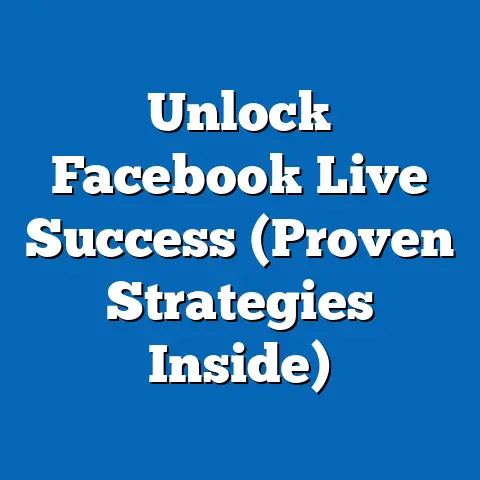Unlocking Obama’s Facebook Strategy (Proven Engagement Tactics)
In today’s digital age, social media isn’t just a platform for sharing selfies and cat videos; it’s a powerful tool for shaping public opinion, driving social change, and building communities around shared values. Environmental awareness has emerged as a critical issue, capturing the attention of individuals and organizations alike. Brands are increasingly recognizing the importance of aligning with eco-conscious values to resonate with their target audiences. And in the realm of politics, leveraging social media to promote sustainability and environmental responsibility can be a game-changer.
That’s where Barack Obama’s Facebook strategy comes into play. More than just a political campaign, it was a masterclass in community engagement and a powerful demonstration of how to use social media to amplify eco-conscious initiatives. I remember being glued to my newsfeed during the 2008 election, witnessing firsthand how Obama’s team harnessed the power of Facebook to connect with voters on a deeply personal level. It wasn’t just about policy; it was about shared values, a sense of community, and a vision for a better future – a future where environmental responsibility was a core principle.
In this article, I’ll dissect Obama’s Facebook strategy, uncovering the engagement tactics that made it so successful. We’ll explore how he built an authentic online persona, crafted compelling content that resonated with his audience, fostered a sense of community, and leveraged data to target his messaging effectively. By understanding the key elements of Obama’s approach, you can apply these proven tactics to your own social media efforts, whether you’re promoting a brand, advocating for a cause, or simply trying to build a more engaged online community.
1. The Foundation of Obama’s Facebook Presence
Obama’s entry into social media, particularly Facebook, during his presidential campaigns was nothing short of revolutionary. It marked a significant shift in how political campaigns were conducted, moving away from traditional media and embracing the power of direct engagement with voters online.
One of the key pillars of his success was building an authentic online persona. It wasn’t just about broadcasting messages; it was about creating a genuine connection with his audience. This involved sharing personal stories, expressing his values, and engaging in conversations with his followers. I recall seeing posts where Obama shared anecdotes about his family, his upbringing, and his commitment to public service. These personal touches made him relatable and human, fostering a sense of trust and connection with his audience.
Transparency was another crucial element of Obama’s Facebook strategy. His team made a conscious effort to be open and honest with their followers, addressing concerns, answering questions, and acknowledging mistakes. This transparency built credibility and fostered a sense of trust, which is essential for building a strong online community.
But what truly set Obama’s Facebook strategy apart was his focus on eco-conscious narratives. He recognized that environmental issues were a top priority for many young voters, and he used his platform to advocate for sustainability, renewable energy, and environmental protection. I remember seeing posts where he highlighted his commitment to reducing carbon emissions, investing in clean energy technologies, and protecting natural resources. This eco-conscious messaging resonated deeply with a younger, environmentally aware audience, setting the stage for deeper engagement and community involvement.
Key Takeaway: Building an authentic online persona, prioritizing transparency, and aligning with eco-conscious values are essential for establishing a strong foundation for engagement on Facebook.
2. Content That Resonates
Content is king, and Obama’s Facebook strategy was a testament to the power of crafting compelling content that resonates with your target audience. It wasn’t just about pushing out generic messages; it was about creating content that was informative, engaging, and aligned with his audience’s values.
One of the key elements of his content strategy was promoting sustainability and environmental issues. He used his platform to share information about climate change, renewable energy, and environmental conservation. He also highlighted the importance of individual actions, encouraging his followers to make small changes in their daily lives to reduce their environmental impact. I remember seeing posts where he shared tips on how to conserve energy, reduce waste, and support sustainable businesses.
Visual storytelling played a crucial role in Obama’s Facebook strategy. Images and videos were used to highlight eco-friendly initiatives, showcase community service efforts, and convey powerful messages about environmental stewardship. I recall seeing videos of Obama visiting national parks, participating in community cleanups, and meeting with scientists working on climate change solutions. These visuals brought his message to life and made it more engaging for his audience.
Relatability was another key factor in the success of Obama’s content strategy. He shared personal stories related to environmental consciousness, highlighting his own efforts to reduce his carbon footprint and live a more sustainable lifestyle. He also shared stories of ordinary people who were making a difference in their communities, inspiring others to take action. I remember reading posts where he talked about his family’s efforts to recycle, conserve water, and reduce their energy consumption. These personal stories made him relatable and human, fostering a deeper connection with his audience.
Key Takeaway: Crafting compelling content that promotes sustainability, utilizes visual storytelling, and emphasizes relatability is essential for resonating with your target audience on Facebook.
3. Community Building and Interaction
Obama’s Facebook strategy wasn’t just about broadcasting messages; it was about building a community and fostering meaningful interaction with his followers. He understood that social media is a two-way street, and he actively engaged with his audience, creating a sense of belonging and shared purpose.
One of the key tactics he used to foster a sense of community was encouraging interaction. He regularly asked questions, solicited feedback, and invited his followers to share their thoughts and experiences. He also used polls and quizzes to engage his audience and gather valuable insights. I recall seeing posts where he asked his followers about their favorite environmental initiatives, their ideas for reducing carbon emissions, and their concerns about climate change.
Q&A sessions and live videos were another powerful tool for building community and fostering interaction. Obama regularly hosted Q&A sessions on Facebook Live, answering questions from his followers on a wide range of topics, including environmental issues. These live sessions allowed him to connect with his audience in real-time, building trust and fostering a sense of transparency.
Responding to comments in a personable manner was also crucial for building community. Obama’s team made a conscious effort to respond to as many comments as possible, acknowledging feedback, answering questions, and addressing concerns. This personalized approach made his followers feel valued and heard, strengthening their connection to the campaign.
Key Takeaway: Encouraging interaction, hosting Q&A sessions and live videos, responding to comments in a personable manner, and creating forums for discussion are essential for building community and fostering engagement on Facebook.
4. Leveraging Data for Targeted Engagement
Obama’s Facebook strategy wasn’t just based on intuition; it was driven by data. His team understood the importance of leveraging Facebook’s analytics tools to understand their audience, tailor their messaging, and optimize their campaigns.
One of the key elements of their data-driven approach was understanding follower demographics and preferences. Facebook’s analytics tools provided valuable insights into the age, gender, location, interests, and behaviors of Obama’s followers. This information allowed his team to segment their audience and create targeted content that resonated with specific groups. For example, they might create a post about renewable energy that was targeted specifically to young voters in states with a strong interest in clean energy technologies.
A/B testing was another crucial tool for optimizing Obama’s Facebook strategy. His team regularly tested different versions of their posts, headlines, images, and calls to action to determine what drove the most engagement. They would then use this data to refine their content and improve their results. I recall reading articles about how Obama’s team used A/B testing to optimize their fundraising appeals, resulting in a significant increase in donations.
Successful posts that led to increased engagement and sharing among eco-conscious followers were carefully analyzed to identify the key elements that made them effective. This information was then used to inform future content strategies, ensuring that their messaging continued to resonate with their target audience.
For example, a post about Obama’s commitment to protecting national parks might generate a high level of engagement and sharing among eco-conscious followers. By analyzing the post, his team could identify the key elements that made it successful, such as the use of stunning visuals, the emphasis on environmental stewardship, and the call to action to support conservation efforts. They could then use this information to create similar posts in the future, maximizing their impact.
Key Takeaway: Leveraging Facebook’s analytics tools, conducting A/B testing, and analyzing successful posts are essential for understanding your audience, tailoring your messaging, and optimizing your engagement on Facebook.
5. The Legacy of Obama’s Facebook Strategy
The long-term impact of Obama’s Facebook strategy on political campaigning and social media engagement is undeniable. He demonstrated the power of social media to connect with voters on a personal level, build communities around shared values, and drive social change.
His eco-conscious approach has inspired other political figures and organizations to adopt similar strategies, focusing on community and environmental issues. I’ve seen numerous examples of politicians and organizations using social media to advocate for sustainability, renewable energy, and environmental protection. They’re using the same tactics that Obama employed, such as sharing personal stories, engaging in conversations with their followers, and creating forums for discussion around eco-conscious topics.
The implications for future campaigns are clear: integrating eco-consciousness into social media strategies is no longer optional; it’s essential. Voters, particularly young voters, are increasingly concerned about environmental issues, and they expect their leaders to take action. By aligning with eco-conscious values, political figures and organizations can build trust, foster engagement, and mobilize support for their campaigns.
Key Takeaway: Obama’s Facebook strategy has had a lasting impact on political campaigning and social media engagement, demonstrating the power of eco-consciousness to build community and drive social change.
Conclusion
Obama’s Facebook strategy was a masterclass in engagement, demonstrating the power of social media to connect with audiences on a personal level, build communities around shared values, and drive social change. The key engagement tactics he employed, such as building an authentic online persona, crafting compelling content that resonated with his audience, fostering a sense of community, and leveraging data to target his messaging effectively, can be applied to various fields, not just politics.
Eco-consciousness can serve as a powerful tool for building community and enhancing engagement on social media. By aligning with eco-conscious values, brands, organizations, and individuals can tap into a growing audience of environmentally aware individuals who are eager to connect, collaborate, and support each other in their efforts to promote sustainability.
I encourage you to reflect on how you can incorporate these strategies into your own social media practices, particularly in promoting eco-friendly initiatives. Whether you’re a business owner, a nonprofit leader, or simply an individual who cares about the environment, you can use social media to make a difference. Start by building an authentic online persona, crafting compelling content that resonates with your audience, fostering a sense of community, and leveraging data to target your messaging effectively. Together, we can use social media to create a more sustainable and equitable future for all.






